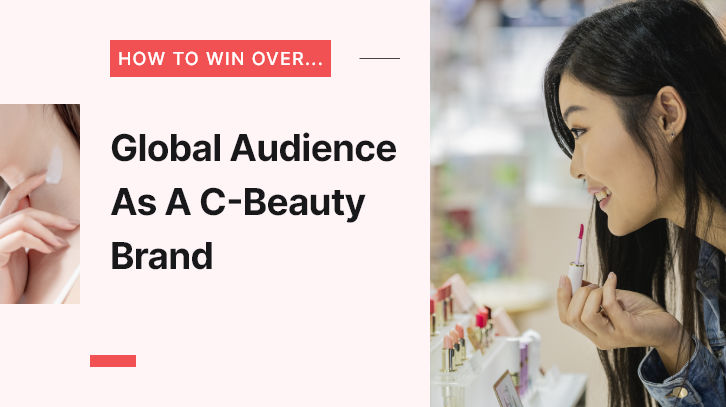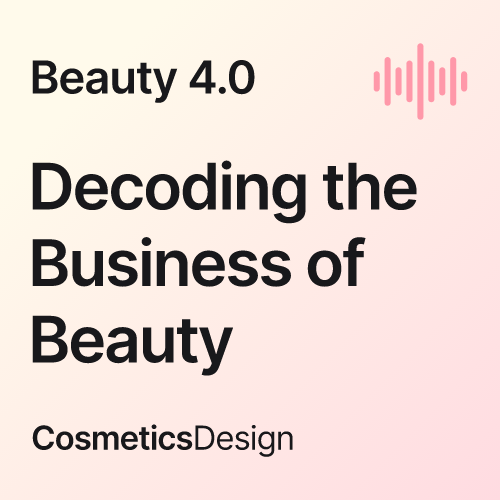How to win over...
How to win over… the global beauty consumer as a C-beauty brand

Last December, in an interview with CosmeticsDesign-Asia, Maxime De Boni, said that C-beauty brands – Chinese cosmetic brands – were on track to becoming a powerful driving force in the global beauty market.
“China has a growing beauty market and a vibrant start-up ecosystem, fostering innovation across various segments of the industry, which makes C-Beauty a fast-rising wave and a growth engine of North Asia and the world,” said the vice president of L'Oréal research and innovation, North Asia and China.
True enough, 2024 has turned out to be a stellar year for C-beauty in terms of gaining international prominence.
In February, L’Oréal announced a minority investment To Summer (观夏) through Shanghai Meicifang Investment Co., a subsidiary of L'Oréal China supported by L'Oréal's venture arm BOLD.
The investment marks the French beauty major’s second investment in a Chinese fragrance brand after participating in a Series A round of funding for Documents (闻献) back in 2022.
Gabby Chen, president of global expansion for Florasis (花西子), told us in May that the brand was prioritising international expansion with a focus on the US. Chen also said it was eyeing expansion into Europe and the Middle East.
In June, C-beauty makeup brand Flower Knows (花知晓), known for its ornate and whimsical product packaging, announced it had entered the US market through retailer Urban Outfitters, greatly expanding its accessibility stateside.
The growing presence of C-beauty can also be seen from CosmeticsDesign-Asia’s base in Singapore, where brands such as Flower Knows, Skintific, Innoherb (相宜本草), Winona (薇诺娜), Catrice (卡翠丝), and Judydoll (橘朵) are increasing their presence both on and offline.
After years of honing their product development and marketing strategies, C-beauty brands have grown confident that their products can stand shoulder-to-shoulder with other brands in the global market.
“C-Beauty is becoming a significant player in the global cosmetic industry, with a notable presence in Asian markets. Additionally, C-beauty brands are actively expanding their reach into international markets,” said Kevin Zhang Zilong, founder of KEV Beauty, a Chinese beauty industry aggregator.
According to data from China Customs, China’s beauty exports totalled at US$2.8billion in the first half of 2023, a year-on-year increase of 32.5%.
The rise and rise of C-beauty
In the past five years or so Zhang has observed how quickly local consumers have come to embrace local brands.
“Chinese consumers used to love Japanese and South Korean brands. They also favoured European and American brands from the big groups. Domestic brands were thought to be not as good. But today, the domestic brands are the trusted favourites of many consumers,” he said.
Zhang credits the advancements across the local beauty industry that have subsequently raised the standards of C-beauty.
“The technological innovation and manufacturing upgrading brought about by Industry 4.0, and the continuous years of investment in scientific research on raw materials, ingredients, formulas, processes, et cetera. These factors have enabled Chinese beauty products to attain an international standard of quality and strength.”
Wang Chang, regional business director, beauty, home and pharma, Lubrizol, underscored that Chinese beauty brands have been maturing for years under the growth of international players.
“All the local brands have watched all the important brands like L’Oréal, LVMH, and Estée Lauder. They have studied K-beauty trends and how to capture the attention of young consumers. They have also seen how J-beauty brands balanced science with elegance. C-beauty is strong because it’s an accumulation of knowledge and accumulation of confidence. It’s not an overnight sensation and that’s why we strongly believe in C-beauty,” he said.
In April, the ingredients company announced it was extending its partnership with Chinese beauty major PROYA (珀莱雅).
Zhang expressed his confidence that C-beauty will enjoy success beyond China and on the international stage.
“Contemporary C-Beauty has effectively transcended the ‘cheap’ label, leveraging robust research and manufacturing capabilities, coupled with a distinctive Chinese Eastern cultural heritage, to emerge as a formidable trendsetter,” said Zhang.
“Through product innovation and strong reputation, we have gained the love and recognition of an increasing number of consumers worldwide. This is what makes me the most proud and happy.”
SEA: The natural first step
In July, KEV Beauty partnered with South China Beauty Expo (SCBE) to host a joint exhibition in Shenzhen, China.
The KEV Beauty Circle Overseas Pioneer Brand Joint Exhibition brought together 11 leading C-beauty brands that were forging their paths overseas.
This included pioneering beauty device company TOUCHBeauty, acne care specialist YOU&PURE (羽素), Gen Z favourite makeup brand Chioture (稚优泉), the original ‘lip mud’ creator INTO YOU (心慕与你), and makeup setting specialist PRAMY (柏瑞美).
Many of these brands have just started expanding beyond the Chinese market and often, the first port of call is South East Asia. To many Chinese brands, the expansion to SEA is a natural step. The region is home to a large population of overseas Chinese, many of whom are descendants of immigrants that started to travelled south with the Maritime Silk Road over 2,000 years ago.
While Japanese and Korean beauty brands have a huge influence on SEA, many of the countries in SEA have young populations that are open to experimenting with new brands. They can also be price-sensitive and driven by good value.
The region is also extremely diverse. Not only is the population made up of different ethnicities and cultures, SEA also has a range of markets with emerging markets like Vietnam to mature markets like Singapore.
Furthermore, we are also starting to see Chinese retailers make their entry into SEA, notably popular lifestyle store KKV, which has expanded to Indonesia and Malaysia.
Together, all these factors make SEA an excellent test bed for China’s fledging and more established beauty brands alike.
Makeup brand Chioture made its first foray into the international market for the first-time last year, expanding into Indonesia, Thailand, and Vietnam.
“The expansion has been going very well. I think it’s because we have a very wide range of products so people can always find their preferences among our products. We also made good partnerships like our partner in Indonesia, which is very strong in offline selling,” said Susie Jiang, head of overseas marketing, Chioture.
“When we started, we set a GMV target, and we already managed to surpass that goal. Our overseas business is still very small but it’s growing very fast. We are making plans to expand more into markets like Singapore.”
The brand sees a lot of affinity with the SEA region as it has a large young population and would resonate with its products. According to Jiang, Indonesia is currently the brand’s best-performing overseas market.
The success of the brand in SEA is now motivating the brand to expand further and it is now eyeing opportunities in the Middle East and North America.
Alex Zan, who heads overseas business development for PRAMY told us that its reception in Vietnam has been extremely promising.
“We’ve just come up on a year in Vietnam and during that time, our GMV was around RMB30,000,000 (USD4.16m). By our conservative estimates, we expect that in three years this will grow to RMB1.5bn (USD207m).”
The brand just expanded into Thailand last year with beauty retailers such as Eve And Boy and is also confident about its growth moving forward.
C-beauty’s competitive edge
The rise of C-beauty domestically can be partially attributed to the guochao (国潮) movement that intensified during the COVID-19 pandemic. While national pride might have spurred on some consumers to try a locally-made product, their continued patronage would boil down to efficacy and performance.
China’s beauty consumers are notoriously discerning and are not afraid to challenge brands to do better. For instance, Perfect Diary has been criticised by consumers in the past of not conducting enough research and development, prompting parent company Yatsen Holdings to make significant investments in that area.
Yu Qin Man, public relations manager of YOU&PURE, emphasised the intense competition in China coming from foreign brands and its local counterparts. The competition is even steeper through cross-border e-commerce platforms.
“If you don’t step up on R&D, product, ingredients, you cannot do well in China. Today’s consumer is country blind. It doesn’t matter if its Japanese, Korean, European, they just want a product that does the job,” Yu told us.
Founded in 2011, YOU&PURE claims that it has over a decade of experience in developing acne-care products. The brand champions gentle yet effective acne solutions. Its Colloidal Sulfur Anti-Acne Essence II claims to soothe redness by 13.61% in an hour and relieve acne by 28.57% In 12 hours. The firm said the products are tested with independent laboratory SGS.
In addition to effective scientific communication, the brand also has to catch the attention of consumers in a crowded online space, and it does so with a striking yellow bottle. This design is exclusive to the brand.
Successful C-beauty brands often are masters at marketing their products online and it is not as easy as engaging a successful key opinion leader (KOL) to sell the product.
Jiang explained that Chioture takes an extremely personalised approach to online marketing as each online platform may have different audiences or need different methods.
“For instance, the Dewu (得物) platform caters to high school students. So, we produce mini gifts sets for that platform. We’re deep into personalising for our audience and have different strategies for each platform.”
And Chioture’s approach to personalisation does not stop there.
“For live streaming, we have different departments with each department focused on a single product to make sure we are selling that one product to the best of our ability. These teams focus on one product so know the product the best and they are able to sell it the best,” said Jiang.
For brands that may not have the manpower to spare, the alternative is to go all out and back one hero product.
Hair care brand Spēs (诗裴丝) is best-known for their dry shampoos. The product is a hot seller on Douyin as it is before and after use is demonstratable on video.
According to Grace Zhao, international business development director of Spēs, its popularity on Douyin has spread to SEA and others, prompting the firm to expand overseas.
“Once people know about our dry shampoo and try our dry shampoo, we are then able to promote more of our products,” she said.
Zhao emphasised that the company has its own laboratory and R&D is done in-house. The company focuses on developing functional hair care product to solve various needs and concerns. She added that the company stays close to its large follower base to learn more about their problems and potential create solutions for them.
PRAMY shares a similar strategy as well. The brand specialises the development of makeup setting products, which feature its patented film-forming agent. Its claims to be the brand with the most comprehensive makeup setting range.
Its most recognisable product is its makeup setting spray which does not contain alcohol and is housed in a patented spray bottle. The brand also has eyeshadow primers and a range of setting powders, including a plant-based one. PRAMY’s R&D and manufacturing is all done in-house.
By carving this niche for itself, PRAMY has managed to cut through the noise on the market and established itself as an expert in its chosen category.
To hear more insights on C-beauty by Zhang, check out this video below:
Challenges and drawbacks
Despite the prowess of C-beauty, these brands still face the same hurdles as other brands in their quest to build an international presence.
“In order to expand into overseas markets, it is essential to adhere to local cosmetic regulations, respect cultural differences, penetrate the local consumer market, understand consumer preferences, and develop products and formulations tailored to local consumers. This process of building consumer trust and increasing brand awareness requires a continuous investment in operations,” said Zhang.
Many C-beauty brands also face their own unique challenges. For instance, most of these brands will have to contend with a vastly different social media and e-commerce landscape abroad, which is less sophisticated that what they are used to.
“When you go out of China, you’re starting from zero. Our social media platforms are different, we have no Instagram and Facebook so there’s no brand awareness at all. To me, that is the biggest challenge. As we expanded overseas, we started to have Instagram and Facebook, which our distributors help us to manage according to the local languages and culture. It’s like you’re starting right back from square one,” said Zan.
However, Zan believes C-beauty brands are up to this challenge.
“The good news is that we have the expertise and the experience to make it a success like we’ve done in China. We are good at spreading word about our brand and our products very quickly to as many people as possible. We know how to work with KOLs, celebrities, brand ambassadors, and we will deploy these methods as we grow our brands overseas.”
Then there are the more nefarious challenges.
Zhao told us that the success of Spēs has been a double-edged sword. The brand had observed many fakes springing up at considerably lower prices. Spēs engages KOLs to help teach consumers how to spot the inauthentic products.
China’s fragrance: What will it take?
At SCBE this year, there was also a fragrance pavilion showcasing the many small fragrance labels that have emerged on the back of a heightened interest in fragrance and the success of brands like Documents and To Summer.
In February, we explored the possibility that Documents could be the brand that put C-beauty on the map.
Clean Beauty Asia founder and China market guru Allie Rooke told us that Documents was “not like the others” and seems to have what it takes to become a global force.
“When L’Oréal invested in Documents, everyone thought this brand had the potential to go global. And if you look at it compared to so many of the previous C-beauty brands, there’s something different about Documents in terms of aesthetics – it’s really a brand-led brand.
“They have been very disciplined in the way they’ve packaged everything, and in their store aesthetics. They’ve opened 10 stores in two years – and that’s 10 standalone stores. They have a very high average basket size, around USD200, which is massive for a Chinese brand. They also have very high repurchase rates and conversion rates.”
Compared to skin care or makeup, the fragrance market in China is much smaller and has much more room to grow. This business opportunity is what attracts many to this category.
However, Zhang Youxi, an independent perfumer, believes it Chinese fragrance brands face an uphill battle more challenging than the other categories. The founder of Wuqi Fragrance said she considers China’s fragrance industry still in its infancy.
“I think Chinese fragrance brands have produced good fragrances and they are very thoughtfully produced. But it still gives me the impression that it is a Western interpretation of what a Chinese person might want from a perfume.”
Youxi told us that the question of how Chinese fragrance brands may succeed internationally was one she has been brooding over.
“Today, if Chinese fragrance brands expand overseas, I think their flaws and weaknesses will be magnified. After all, the fragrances are still in the Western style – even if it has osmanthus in it. I believe that a Chinese brand must have something that is a speciality of China within it.”
She added: “A Chinese artist painting a Chinese scene with ink wash painting techniques will be more authentic than using Western oil painting techniques.”
Youxi elaborated that in order for China to develop a truly Chinese fragrance identity, the local industry must start right from the beginning and explore the ingredients and materials its vast country has to offer.
“This would take a lot of financial resources. Unfortunately, not many people will be willing to make that investment,” she said.
C-beauty’s innovation, quality and accessible pricing will no doubt garner it many fans beyond the Middle Kingdom. The space holds tremendous promise and it is exciting to watch it develop and better discover its own identity like how Japanese, Korean, and Thai beauty brands have.
Zhang concluded: “The definition of C-Beauty is still evolving, and there is currently no consensus on a single, unified definition. It is my personal opinion that C-Beauty stands for good quality, cost-effective, more in line with consumer preferences, and possesses a unique cultural attribute.”



![[Getty images]](/var/wrbm_gb_food_pharma/storage/images/_aliases/wrbm_medium/publications/cosmetics/cosmeticsdesign-asia.com/headlines/packaging-design/beauty-broadcast-how-beauty-minis-are-shaping-trends-packaging-innovation-sustainability/17656471-1-eng-GB/Beauty-Broadcast-How-beauty-minis-are-shaping-trends-packaging-innovation-sustainability.jpg)
![L'Oréal sees tremendous opportunity for L'Oréal Paris to recruit new customers in China. [L'Oréal Paris]](/var/wrbm_gb_food_pharma/storage/images/_aliases/wrbm_medium/publications/cosmetics/cosmeticsdesign-asia.com/headlines/business-financial/l-oreal-paris-see-huge-opportunity-in-china-as-consumers-seek-value-for-money/17632744-1-eng-GB/L-Oreal-Paris-see-huge-opportunity-in-China-as-consumers-seek-value-for-money.jpg)
![The recent product news in the Asia Pacific beauty and personal care market. [Lakme]](/var/wrbm_gb_food_pharma/storage/images/_aliases/wrbm_medium/publications/cosmetics/cosmeticsdesign-asia.com/headlines/market-trends/product-profiles-latest-news-on-the-hottest-beauty-products-in-apac2/17640109-1-eng-GB/Product-profiles-Latest-news-on-the-hottest-beauty-products-in-APAC.jpg)





![Shopee Korea targets 300% in Thailand next year as South Korean brands such as COSRX, Fwee, Torriden, and VT Cosmetics surge in demand. [Getty Images]](/var/wrbm_gb_food_pharma/storage/images/_aliases/wrbm_tiny/publications/cosmetics/cosmeticsdesign-asia.com/headlines/business-financial/shopee-korea-aims-for-300-growth-in-thailand-on-the-back-of-k-beauty-boom/17716660-1-eng-GB/Shopee-Korea-aims-for-300-growth-in-Thailand-on-the-back-of-K-beauty-boom.jpg)
![oshinoya Holdings ventures into the beauty sector with the launch of Speedia, a skin care line featuring ostrich oil. [Speedia]](/var/wrbm_gb_food_pharma/storage/images/_aliases/wrbm_tiny/publications/cosmetics/cosmeticsdesign-asia.com/headlines/brand-innovation/ostrich-skin-care-yoshinoya-makes-beauty-entry-to-tap-into-cosmetic-potential-of-ostrich-oil/17698087-1-eng-GB/Ostrich-skin-care-Yoshinoya-makes-beauty-entry-to-tap-into-cosmetic-potential-of-ostrich-oil.png)
![An aesthetic physician hopes to see the potential of personalised skin care realised in the medical aesthetic space. [Getty Images]](/var/wrbm_gb_food_pharma/storage/images/_aliases/wrbm_tiny/publications/cosmetics/cosmeticsdesign-asia.com/article/2024/09/10/aesthetic-physician-highlights-potential-of-personalised-skin-care-for-effective-patient-care/17698141-1-eng-GB/Aesthetic-physician-highlights-potential-of-personalised-skin-care-for-effective-patient-care.jpg)

![LGH&H has made a strategic investment of KRW5bn (USD3.73m) in a venture capital fund that fosters K-beauty startups. [LG H&H]](/var/wrbm_gb_food_pharma/storage/images/_aliases/wrbm_tiny/publications/cosmetics/cosmeticsdesign-asia.com/headlines/business-financial/lg-h-h-commits-3.7m-in-funding-to-seek-long-term-partnerships-with-k-beauty-start-ups/17712094-1-eng-GB/LG-H-H-commits-3.7m-in-funding-to-seek-long-term-partnerships-with-K-beauty-start-ups.jpg)


![Recent product news from Essentials, Justhuman, Camino Rose, matsukiyo and more. [Camino Rose]](/var/wrbm_gb_food_pharma/storage/images/_aliases/wrbm_tiny/publications/cosmetics/cosmeticsdesign-asia.com/article/2024/09/06/product-profiles-latest-news-on-the-hottest-beauty-products-in-apac/17722207-1-eng-GB/Product-profiles-Latest-news-on-the-hottest-beauty-products-in-APAC.png)


